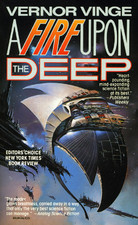A Fire Upon the Deep (Zones of Thought #1), by Vernor Vinge
 A Fire Upon the Deep is a really strange book. The writing style of the author, Vernon Vinge, reminds me a lot of Asimov: the describing of scenes that are clear in his head, but the willingness to move immediately over concepts or ideas that are not, the sometimes obnoxiously long dialogues, the direct way of saying it as it is. In fact, without knowing anything about Vinge, I bet that he is an engineer, maybe even a computer scientist. And I won. The concepts of the book range from high hard sci-fi to naive depictions of kilobyte per second communication. So, in all earnest, I thought the book was amateurish, meanwhile reading it from cover to cover in a few days, just like one of Asimov's books. Still, for a book written in 1992, it felt terribly outdated.
A Fire Upon the Deep is a really strange book. The writing style of the author, Vernon Vinge, reminds me a lot of Asimov: the describing of scenes that are clear in his head, but the willingness to move immediately over concepts or ideas that are not, the sometimes obnoxiously long dialogues, the direct way of saying it as it is. In fact, without knowing anything about Vinge, I bet that he is an engineer, maybe even a computer scientist. And I won. The concepts of the book range from high hard sci-fi to naive depictions of kilobyte per second communication. So, in all earnest, I thought the book was amateurish, meanwhile reading it from cover to cover in a few days, just like one of Asimov's books. Still, for a book written in 1992, it felt terribly outdated.
The plot is a combination of story arches. The main one is the emergence of an evil artificial intelligence that plans to take over the galaxy and the quest to retrieve the ultimate weapon that would defeat it. Then there is the story of a medieval alien race of rat-wolf analogues that think in packs, making an individual from several bodies acting together. And finally there is the internal dynamic of the group that embarks in this quest of quests. Some interesting ideas are being thrown around, but almost always with terrible naivete, such as the Internet Relay Chat type of communications between interstellar civilisations or the distinction of several Zones of the galaxy in which technology and space travel can work at various speeds. The alien creatures, in their vast majority, are badly described with embarrassing slip-ups like using the word "zombie" or some other typical human colloquialisms in an alien context, however some ideas are ingenious. I will list here the way the "tines" use ultrasonics to group think and act like singular entities, while being able to use sound for "interpack" communication. The way a soul of such a creature is affected by the death, addition, injury or indeed torture of one of the individual bodies is also explored, with various degrees of success. The creation or manipulation of an entire race of people in order to further the goals of a "godly" intelligence is also an interesting twist.
To sum it all up, from the three main story arches, the pack intelligence aliens one was the most thorough, while the one relating to AI and space travel and communication was the least. Amazing coming from a computer scientist. In fact, I would have liked the book more if its sole subject was about the accidental marooning of two children on a starship in the middle of a strange alien feudal world. The rest felt clunky and frankly completely ridiculous in most cases. I still read it with interest, although I don't intend to read anything else from Vinge.
Comments
Read it my self almost 20 years ago and I agree. The Tines are the most interesting part of the story but the IRC reference should be taken in the context of internet anno 1993 when the book was written ;) Back then it was plausible.
Elderam